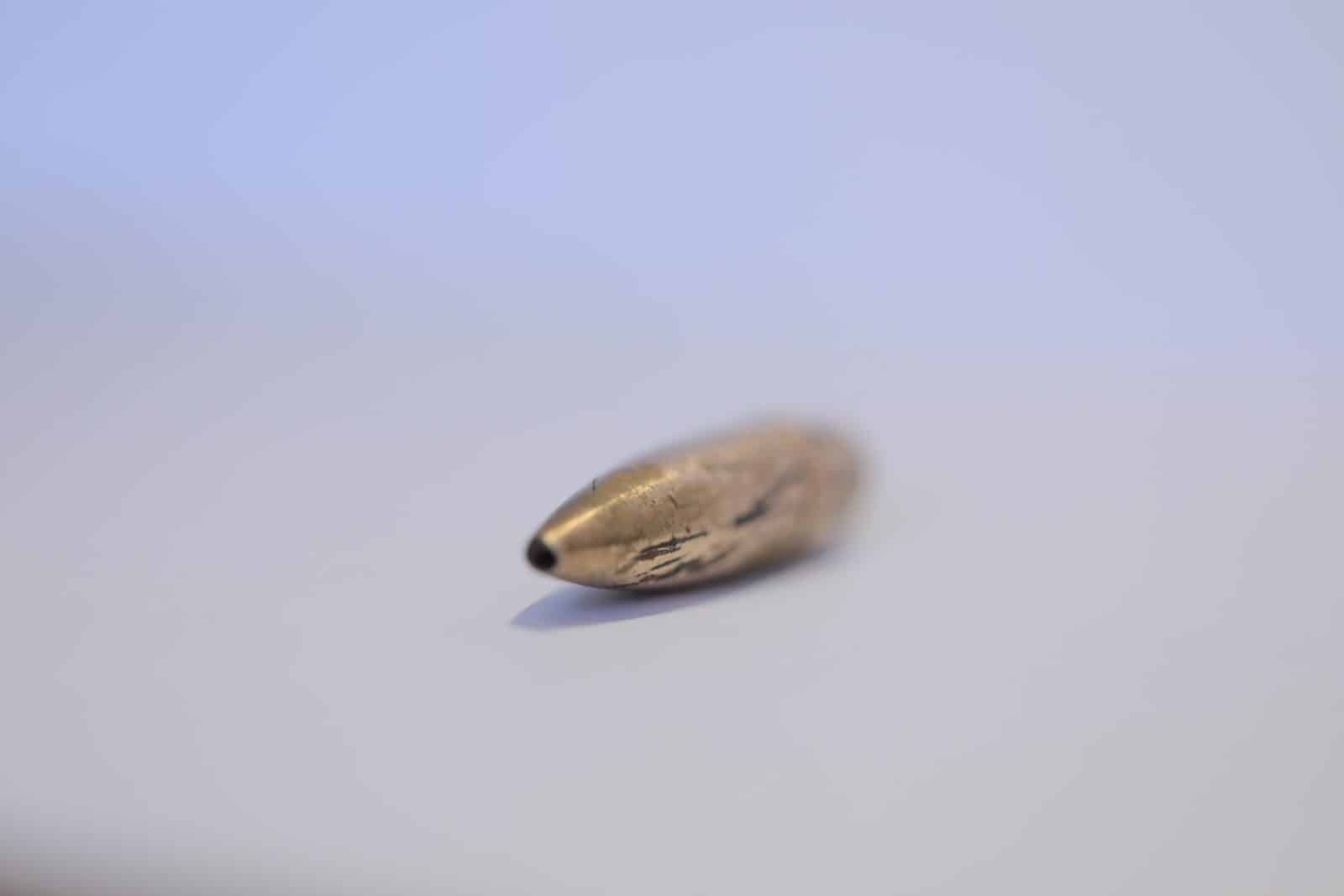
This research grew out of video investigation Triple-Chaser, which premiered at the 2019 Whitney Biennial, and began with an open source investigation of companies connected to Warren B. Kanders, then-vice chair of the board of trustees of New York’s Whitney Museum.
Summary
We pieced together publicly available data from product catalogues, military manuals, and United Nations (UN) reports, and compared this with reports from medical professionals and images shared with us by activists. Our findings suggest that sniper bullets manufactured by Sierra are used by the Israeli army, and would have been used against civilian protesters in Gaza in 2018, during a period in which hundreds of protesters were killed, and during which time, according to the UN, Israeli soldiers may have committed crimes against humanity.
We presented this research to the European Center for Constitutional and Human Rights (ECCHR), a Berlin-based legal NGO dedicated to enforcing civil and human rights worldwide. As part of that mandate, ECCHR engages in efforts to pursue criminal accountability for arms trade organisations for human rights violations committed by third parties using equipment sold by those organisations.
On 8 May 2019, ECCHR wrote to Sierra Bullets to inform them that they are considering legal steps against the company.
According to a 2003 field manual produced by the US Department of the Army, the 7.62mm military rounds designated M118LR [‘Long Range’] and M852 feature bullets manufactured by Sierra. Training manuals produced by the Israeli army in 2013 confirm that the M852 and the M118LR rounds are used by Israeli army snipers. Between March and December 2018, Israeli army snipers killed over 150 civilian protesters and wounded over 6000. A UN Commission recently concluded that the use of live ammunition by Israeli army snipers against civilian protesters in Gaza during that time may amount to war crimes or crimes against humanity. Open source evidence suggests that those snipers were carrying M24 and SR25 rifles, which fire the M852 and M118LR rounds.
Warren B. Kanders
Warren B. Kanders is both a vice chair of the board of trustees of the Whitney Museum of American Art and, since 2002, the Executive Chairman of Clarus Corporation. According to the Clarus Corporation’s 26 April 2019 SEC filing, Kanders is the direct or indirect beneficial owner of 6,683,945 shares of common stock in Clarus Corporation—21.8% of Clarus’ total stock. He is listed with the US Securities and Exchange Commission as a Director and a ‘10% Owner’ of Clarus.
In August 2017, Clarus bought Sierra Bullets, a US-based manufacturer of bullets. Bullets are a component of ammunition; consumers and ammunition manufacturers buy Sierra Bullets to load their ammunition. In 2019, Sierra also began manufacturing and selling ammunition.
Sierra MatchKing
Sierra Bullets, produces a line of ‘open tip’ bullets known as the Sierra MatchKing, designed for long range accuracy in competitive rifle shooting. ‘MATCHKING’ is a trademark of Sierra Bullets, LLC.
According to a 2003 document produced by the US Department of the Army, two variations of the MatchKing are used in two military 7.62mm calibre rounds; these are designated the M118LR [‘Long Range’], and the M852.
W. Hays Parks, formerly a Senior Associate Deputy General Counsel at the Department of Defense, has written and lectured about the military and legal history of open tip munitions. According to Parks, the MatchKing was designed in the 1950s for ‘long range accuracy’ and initially used for competitive shooting.
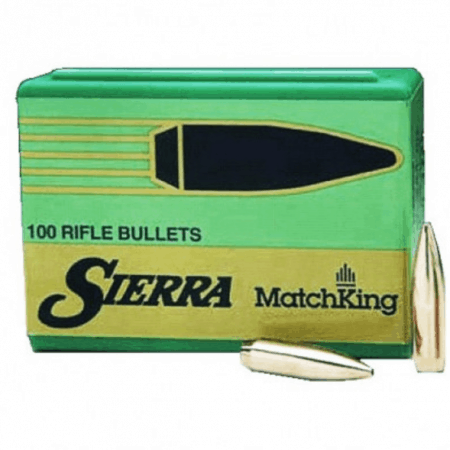
The 168-grain MatchKing, used in the M852 round, was declared legal for sniper combat use by US military lawyers in 1990, during the run-up to Operation Desert Storm, the first US-led invasion of Iraq. The M852 was previously considered to be non-compliant with the 1899 Hague Convention, which prohibited the use of ‘bullets which expand or flatten easily in the human body’.
Although MatchKing bullets are sometimes described as ‘hollow point’, they are not designed to expand upon impact like hollow point bullets such as Sierra’s GameKing. In the case of the MatchKing, the narrower open tip is a result of its manufacturing process, according to Parks.
The slightly heavier 175-grain MatchKing, used in the M118LR round, was authorised for military use in 1997. The 175-grain MatchKing was selected for the M118LR round due to its accuracy over long distance, according to materials produced by the US Naval Sea Systems Command.
The 168- and 175-grain MatchKing bullets are used by Israeli arms manufacturer IMI Systems, formerly known as Israeli Military Industries, in at least two of their commercial ammunition product lines. An IMI product catalogue suggest that both of these rounds ‘improve lethality’.
IMI Systems claims to be a ‘preferred supplier’ to the Israeli army. Cartridge casings found by activists on the Israeli side of the Gaza border fence, close to the Nir Oz kibbutz, are marked with IMI headstamps.
Training manuals produced by the Israeli army in 2013 confirm that the M852 and the M118LR rounds, which include bullets manufactured by Sierra, are used by their snipers. Two individuals who identify themselves as former Israeli army snipers claim to have used Sierra’s 7.62 bullets and praised their accuracy on Hebrew-language web forums.
IMI also claims that its 168-grain Razor Core ammunition features a MatchKing bullet, has been ‘developed for Special Forces requirements’, and that it has ‘military and commercial uses’.

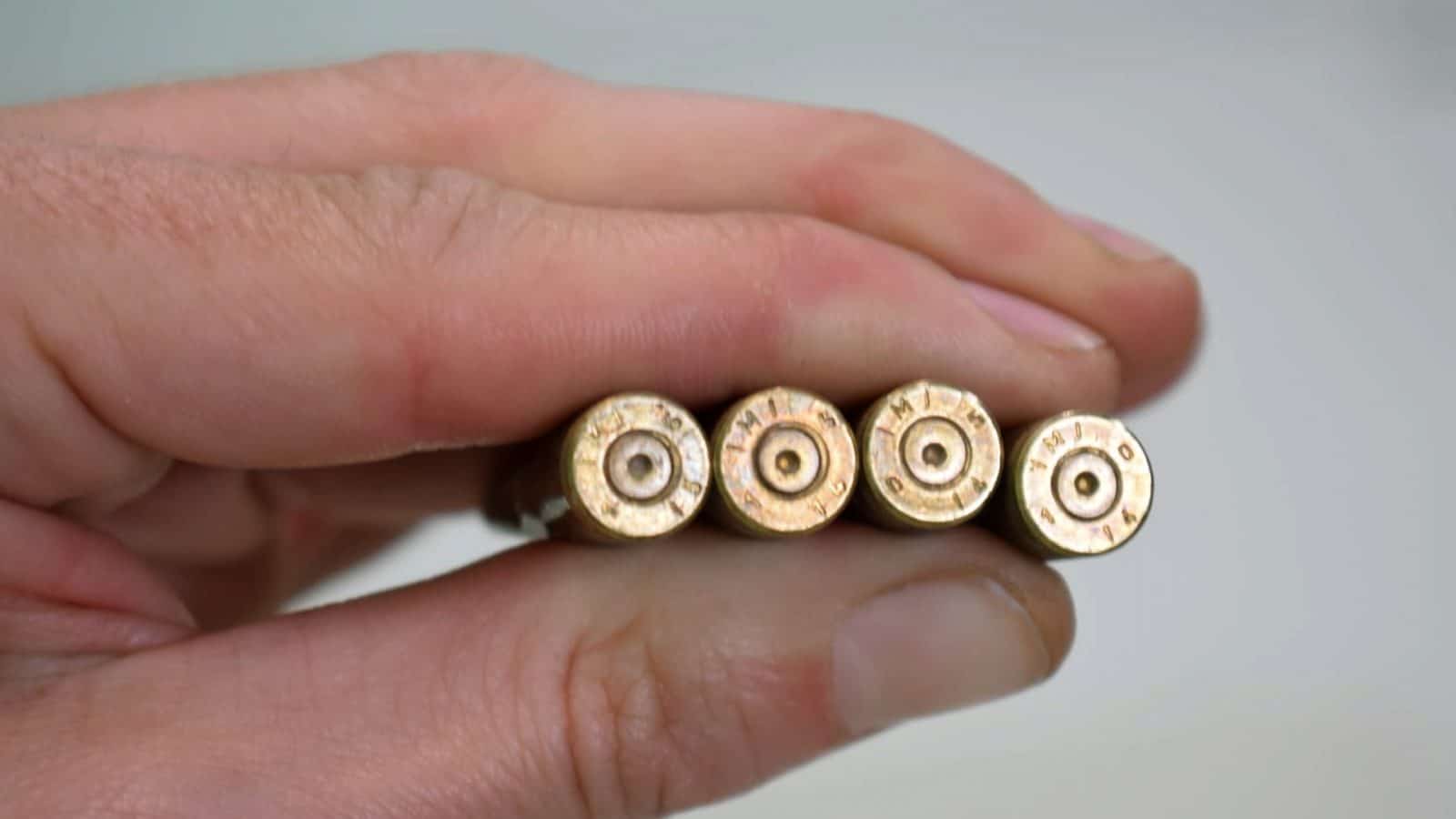
A third-party distributor markets the same IMI ammunition, featuring the 168-grain MatchKing, as ‘in use by the IDF [Israel Defense Forces], U.S. Army and NATO forces’. The 175-grain round is also listed on IMI’s website under ‘military products’.
Reportedly, Kanders tried to purchase IMI in 2015, even establishing a company called Kanders IMI.
The Israeli army at the Gaza border
What appear to be M118LR rounds are visible in images of an Israeli army sniper taking part in training, reportedly with US Special Forces, and firing an SR-25 rifle.
The training manuals produced by the Israeli army describe the use of M118LR and M852 rounds with the M24 rifle.
Images published on 31 March 2018 by the Israeli army, as part of a press release describing their preparations at that time at the Gaza border, shows soldiers carrying both M24 and SR-25 rifles, supporting the possibility that M118LR and M852 rounds—and therefore Sierra bullets—were used in 2018.
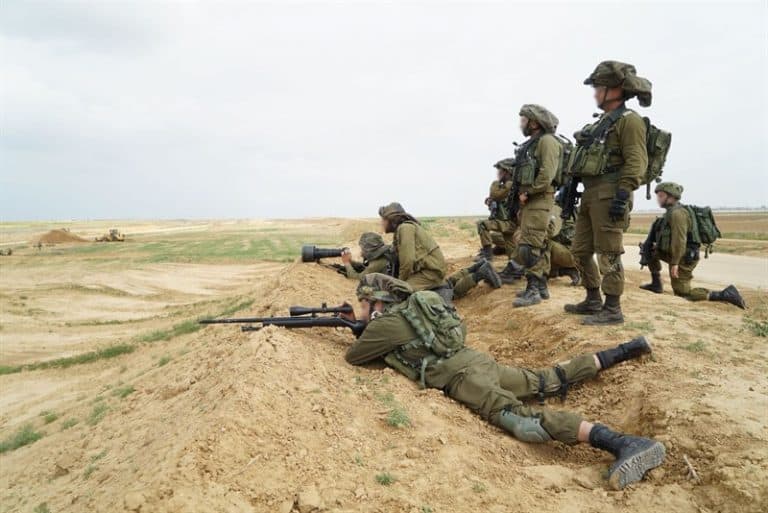
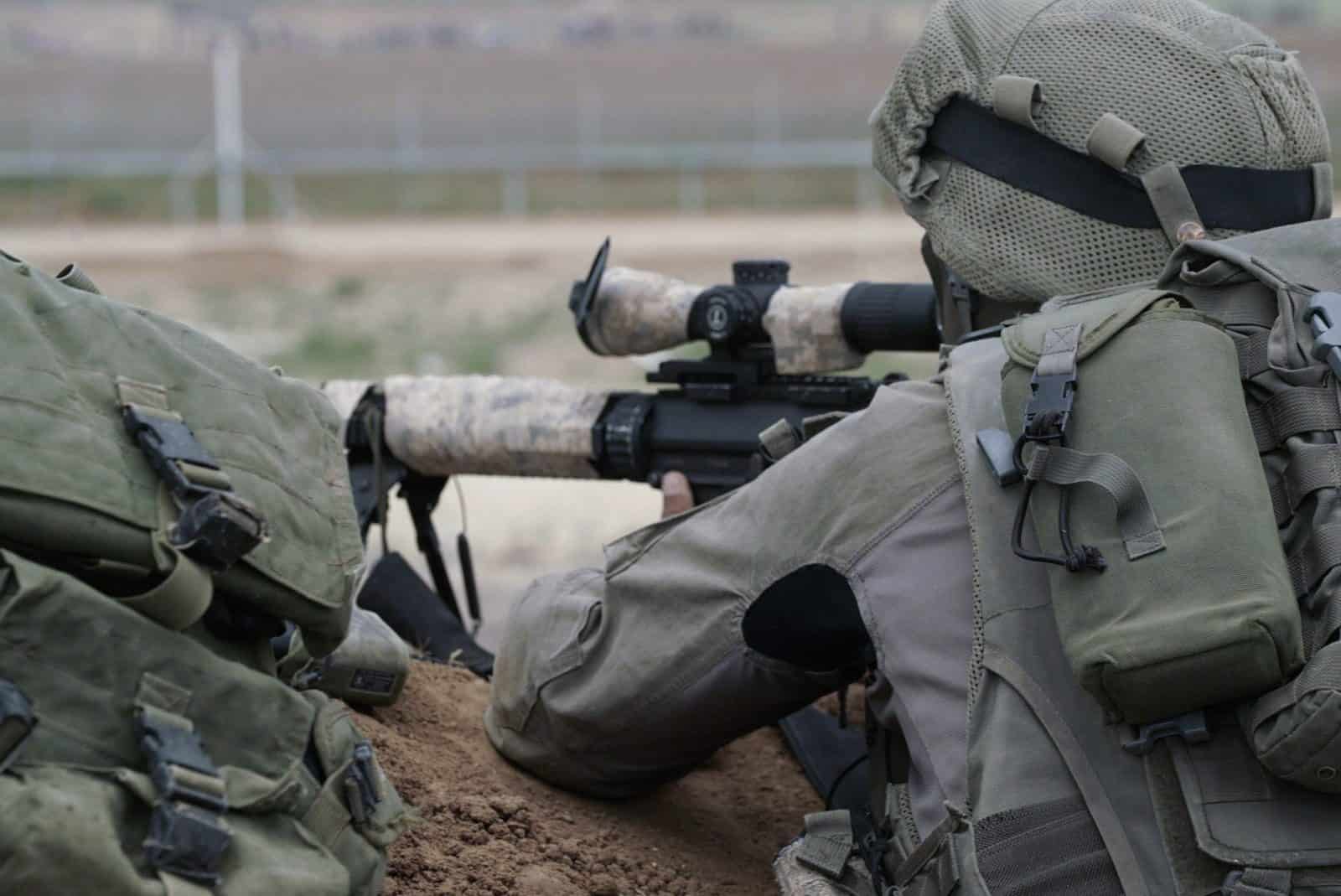
According to a report presented on 28 February 2019 by the United Nations Commission of Inquiry on the 2018 protests in the Occupied Palestinian Territory, between 30 March 2018 and 31 December 2018, live ammunition was repeatedly used by Israeli army snipers against Palestinian civilians during weekly protests along the eastern border of Gaza, known as the ‘Great March of Return and the Breaking of the Siege.’
During those protests, according to the Commission’s report and summary:
- Israeli army snipers killed over 150 civilian non-combatants, including 35 children, with live ammunition. Over 6,000 people were injured by live ammunition, including 940 children.
- Those snipers shot at journalists, health workers, children and persons with disabilities, knowing they were clearly recognizable as such.
- ‘The demonstrations were civilian in nature, had clearly stated political aims and, despite some acts of significant violence, did not constitute combat or a military campaign.’
- ‘The ISF [Israeli Security Forces] violated international human rights law in most instances the Commission investigated. ISF conduct also violated international humanitarian law, which permits civilians to be targeted only when they “directly participate in hostilities.”’
- ‘These serious human rights and humanitarian law violations may constitute war crimes or crimes against humanity.’
The normative framework for civilian demonstrations is one of law enforcement, and is governed by international human rights law. The UN stipulates that ‘lethal means’ within a law enforcement framework can only be employed in response to an immediate and concrete danger to life and as a last resort. In situations where resorting to lethal means is absolutely unavoidable, it should be employed with ‘restraint’, in proportion, and with a view to ‘minimize damage’ and irreversible bodily injury. (a)
The report by the UN Commission found that the Israeli army’s use of lethal force in response to Palestinian civilian protesters along the border with Gaza was ‘rarely necessary or proportionate.’
Severity of injuries
Stanford’s Dr. Gary K. Roberts suggests that the MatchKing bullet used in the M118LR round is prone to breaking up or fragmenting following entry into soft tissue, and can ‘exit the target and pose a significant downrange hazard to innocent bystanders’. According to Parks, the M852 round, which features a MatchKing bullet, exhibited a tendency to break up at close range during testing. An unofficial Guide to US Special Forces makes a similar claim, that the M852 would sometimes ‘break up or fragment following entry into soft tissue’.
A 2018 investigation by Forensic Architecture and the New York Times into the killing of Palestinian medic Rouzan al-Najjar documented the lethal consequences of the fragmentation of a single bullet after hitting the ground in the midst of a crowd during the Great March of Return protests.
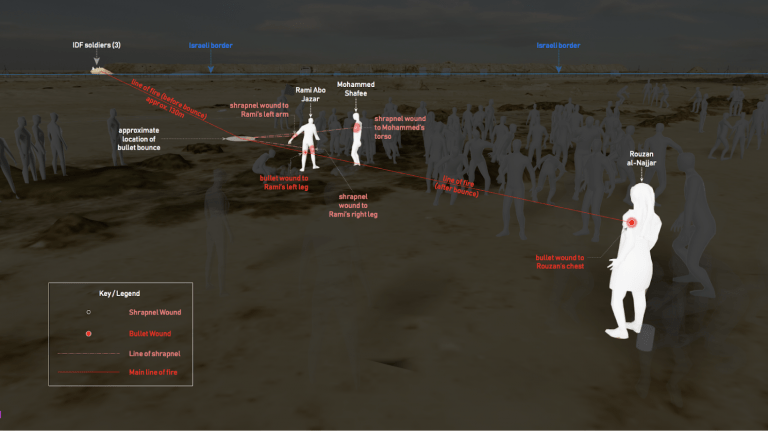
The UN Commission’s report, Amnesty International, MSF, and Defence for Children International all documented severe wounds among Palestinian civilian demonstrators in Gaza during those protests. The UN Commission’s report, as well as reporting by +972, suggests that ‘catastrophic damage to tissue, organs and bone’ was caused by the use of high-velocity munitions, such as 7.62mm calibre bullets, at close range.
Among other factors, higher velocity at the time of impact increases the likelihood of fragmentation inside the body, according to Roberts.
Data published by the US Army (p364-7) recorded the speed of the M118LR and M852 rounds from the moment they are fired, to a range of 1000m. Both rounds exit the barrel at over 1700 miles per hour (mph). At 200m, the M118LR round will still be travelling at just over 1500mph, and the M852 just below. The protest site at which al-Najjar was killed, near Khuzaa, on the eastern border of Gaza, was less than 200m from the border fence.
Medical testimony from Gaza
In March 2019, a Palestinian doctor at Al-Awda Hospital in Jabaliya described the kind of severe injuries caused by live ammunition during the Great March of Return protests: ‘From the shape of the injury [and from] the little pieces of the bullets we can tell that they are not normal bullets. The exit holes are bigger, with more bleeding and more damage.’ (b)
In April 2019, a Palestinian doctor at Shifa Hospital in Gaza City shared this x-ray of an injury sustained in December 2018 with Forensic Architecture’s researcher in Gaza. (c)
According to the doctor: ‘Most of the patients we received had fractures that were not from normal bullets. Normal bullets make a simple fracture… but what we have is an explosion of the bone with… great damage to the soft tissue.’
Echoing our own investigation with the New York Times, the doctor reported that ‘sometimes we had three people hit, one after the other, from one bullet. One bullet, three people.’
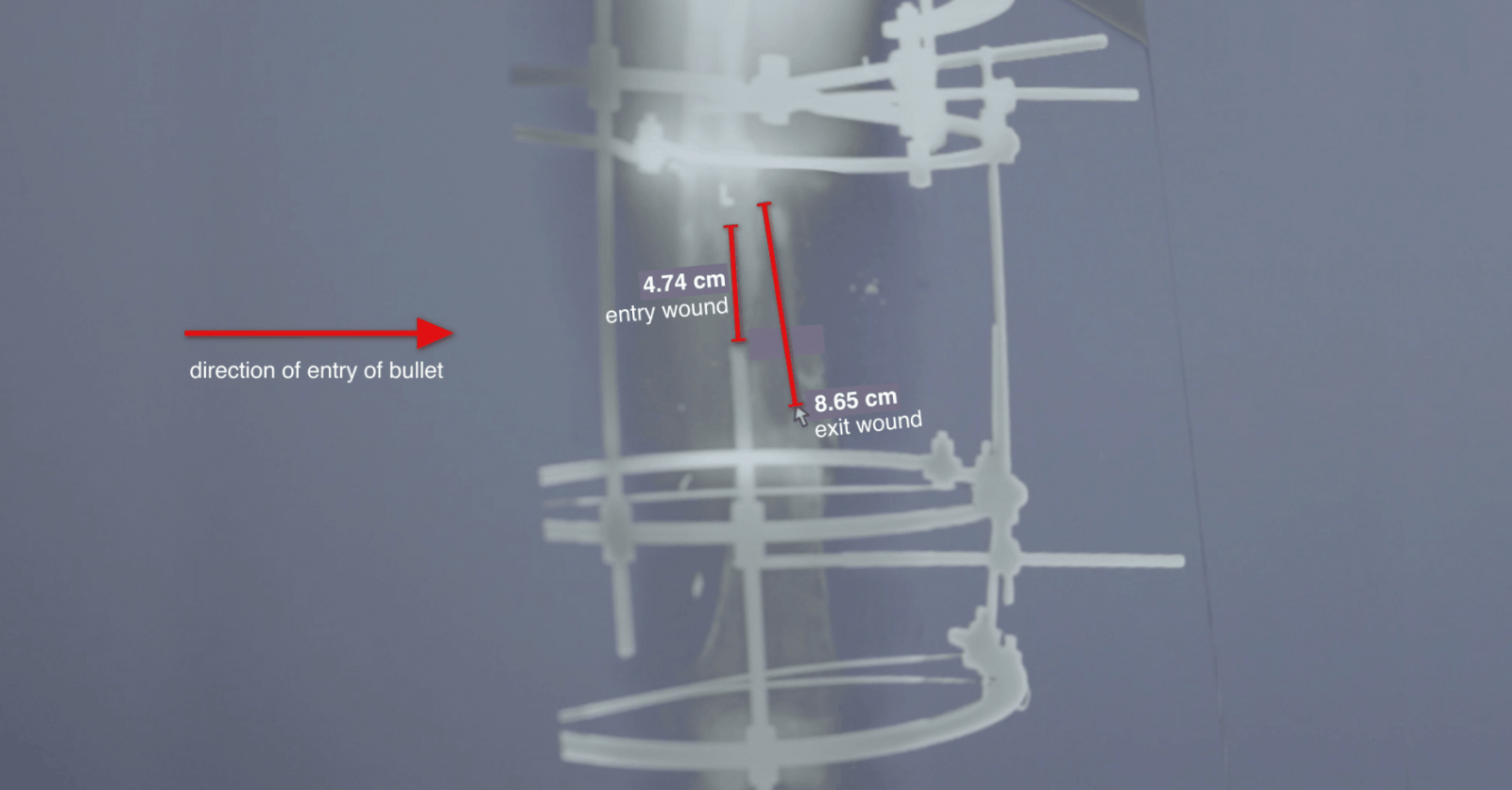
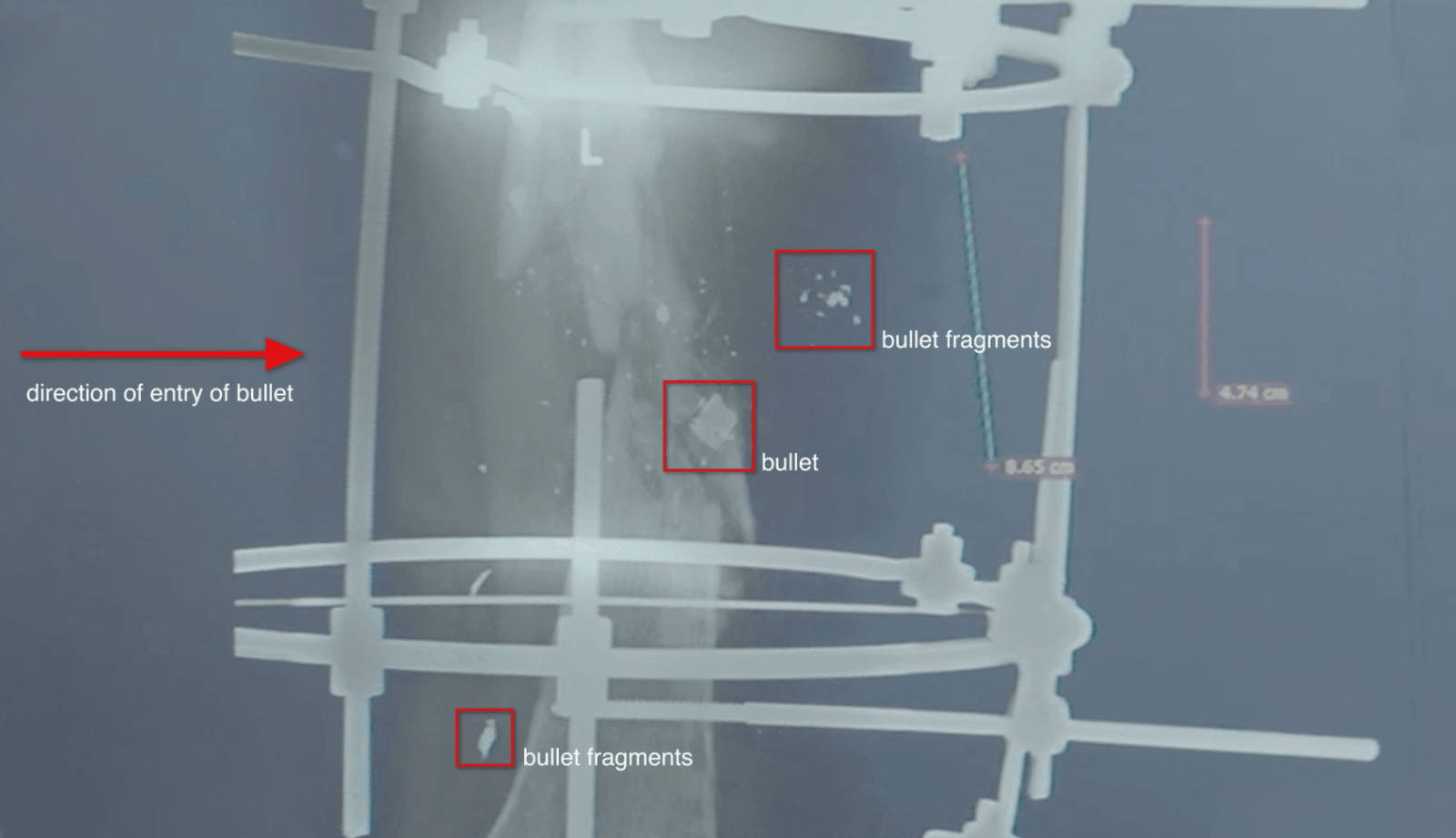
In May 2019, Dr. Basel Alaila, from the Indonesian Hospital in Gaza City, explained to Forensic Architecture’s researcher: ‘The types of injuries we are used to seeing normally result from 5.56mm bullets used by the army. These bullets also do damage, but not like the severe injuries we have witnessed from the bullets used during the protests.’
Dr. Alaila also described the relationship between the fragmentation of the bullet and the kind of injuries sustained by Palestinians during those protests: ‘This bullet is more dangerous than the live bullets normally used… it breaks into many sections that can hit various organs and cause bleeding, which may lead us to remove the organ. These types of wounds often leave the surgeon in Gaza with very little choice; all bad choices.’ (d)
(b) Testimony from Al-Awda Hospital provided to Forensic Architecture's researcher in Gaza by medical practitioner Riccardo Corradini, and filmmakers Chiara Avesani and Matteo Delbo.
(c) Testimony and x-ray images from Shifa Hospital provided to Forensic Architecture's researcher in Gaza by medical practitioner Riccardo Corradini, and filmmakers Chiara Avesani and Matteo Delbo, as part of a forthcoming documentary on health services.
(d) Testimony provided to Forensic Architecture's researcher in Gaza.
Questions to Sierra Bullets
We presented this research to the European Center for Constitutional and Human Rights (ECCHR), a Berlin-based legal NGO dedicated to enforcing civil and human rights worldwide.
As part of that mandate, ECCHR engages, in the words of its spokesperson “to legally challenge the role of arms trade manufacturers in human rights violations committed by third parties using equipment manufactured and exported by transnational companies.”
In April 2018, ECCHR launched legal action against Italian government officials and a European arms manufacturer over Saudi arms sales.
On 8 May 2019, ECCHR wrote to Sierra Bullets to inform them that they are considering legal steps against Sierra Bullets because of their potential liability, in connection with the 2018 protests on the eastern border of Gaza, during which Israeli army snipers killed over 150 civilian demonstrators.
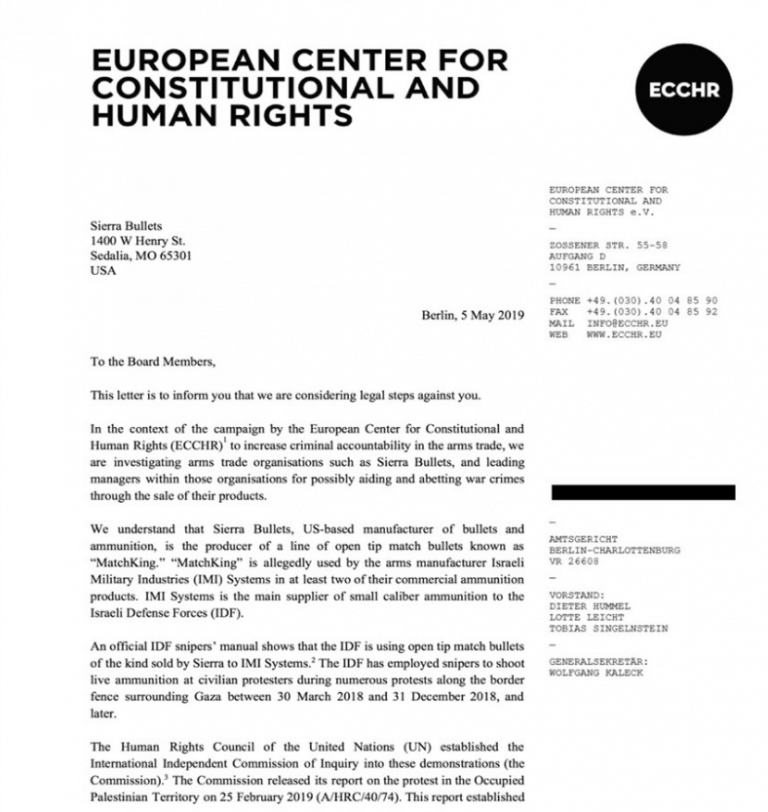
The letter sent to Sierra Bullets included the following questions:
- Is Sierra Bullets aware of the report published by the Commission and the findings therein, in particular the sections on ‘accountability’ (Nos. 106-112) and ‘individual criminal accountability’ (Nos. 113-117)?
- Has Sierra Bullets established any kind of due diligence process according to the UN Guiding Principles on Business and Human Rights (UNGPs)? a. If so, to what conclusions did Sierra Bullets come regarding the export of bullets to IMI Systems?
- Is Sierra Bullets aware of the lawsuit currently in front of the Connecticut Supreme Court in the case of the families of the victims of the Sandy Hook shooting, against the arms manufacturer Bushmaster Firearms International, LLC (FBT-CV-15-6048103-S), and the decision of the Court from 14 March 2019 to proceed in that firearms industry lawsuit?
A possible match
In June 2019, Forensic Architecture researchers found a bullet which appeared to closely match the dimensions of the 175-grain Sierra MatchKing bullet which is used in the ammunition designated M118LR.
However, a handful of physical discrepancies suggest to us that further research and analysis is required before we can conclusively assert that the bullet is a MatchKing manufactured by Sierra Bullets.
Update
 25.07.2019
25.07.2019
Warren B. Kanders resigned from his position on the board of the Whitney Museum, following requests by nine artists (including Forensic Architecture) to have their work withdrawn from the 2019 Whitney Biennial in protest at what was seen as inaction by the museum in response to the Kanders controversy.
Following Kanders’ resignation, the nine artists requested that their work remain in the exhibition.